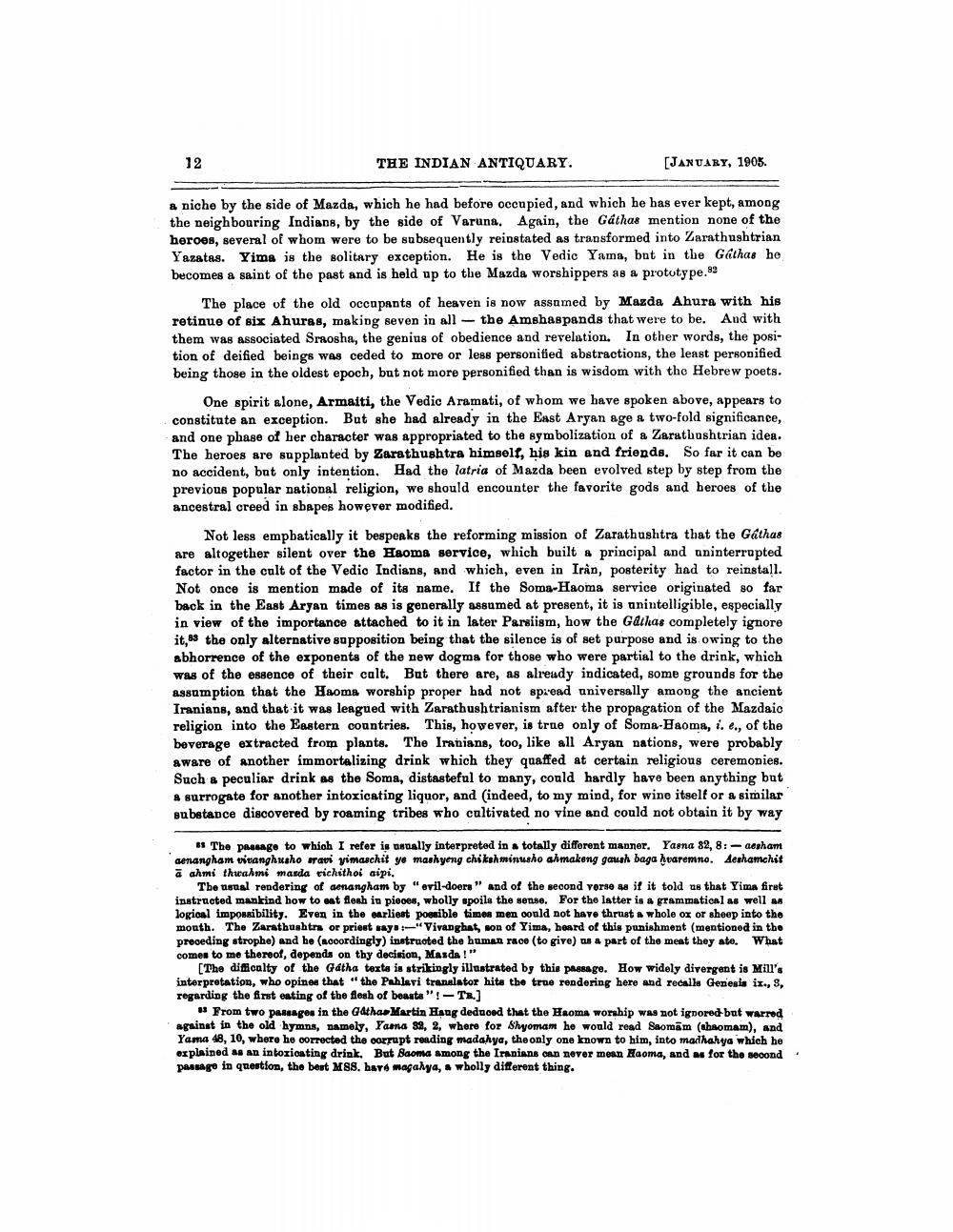________________
12
THE INDIAN ANTIQUARY.
[JANUARY, 1905.
a niche by the side of Mazda, which he had before occupied, and which he has ever kept, among the neighbouring Indians, by the side of Varuna. Again, the Gáthas mention none of the heroes, several of whom were to be subsequently reinstated as transformed into Zarathushtrian Yazatas. Yims is the solitary exception. He is the Vedic Yama, but in the Gathas he becomes a saint of the past and is held up to the Mazda worshippers as a prototype.82
The place of the old occapants of heaven is now assamed by Mazda Ahura with his retinue of six Ahuras, making seven in all the Amshaspands that were to be. And with them was associated Sraosha, the genius of obedience and revelation. In other words, the position of deified beings was ceded to more or less personified abstractions, the least personified being those in the oldest epoch, but not more personified than is wisdom with the Hebrew poets.
One spirit alone, Armaiti, the Vedic Aramati, of whom we have spoken above, appears to constitute an exception. But she had already in the East Aryan age a two-fold significance, and one phase of her character was appropriated to the symbolization of a Zarathushtrian idea. The heroes are supplanted by Zarathushtra himself, his kin and friends. So far it can be no accident, but only intention. Had the latria of Mazda been evolved step by step from the previous popular national religion, we should encounter the favorite gods and beroes of the ancestral creed in shapes however modified.
Not less empbatically it bespeaks the reforming mission of Zarathushtra that the Gathas are altogether silent over the Haoma service, which built a principal and uninterrupted factor in the cult of the Vedic Indians, and which, even in Irån, posterity had to reinstall. Not once is mention made of its name. If the Soma-Haoma service originated so far back in the East Aryan times as is generally assumed at present, it is unintelligible, especially in view of the importance attached to it in later Parsiism, how the Gathas completely ignore it,83 the only alternative sopposition being that the silence is of set purpose and is owing to the abhorrence of the exponents of the new dogma for those who were partial to the drink, which was of the essence of their calt. But there are, as already indicated, some grounds for the assumption that the Haoma worship proper had not spread universally among the ancient Iranians, and that it was leagued with Zarathushtrianism after the propagation of the Mazdaic religion into the Eastern countries. This, hovever, is true only of Soma-Haoma, i. e., of the beverage extracted from plants. The Iranians, too, like all Aryan nations, were probably aware of another immortalizing drink which they quaffed at certain religious ceremonies. Such a peculiar drink as the Soma, distasteful to many, could hardly have been anything but 8 surrogate for another intoxicating liquor, and (indeed, to my mind, for wine itself or a similar substance discovered by roaming tribes who cultivated no vine and could not obtain it by way
# The passage to which I refer is usually interpreted in a totally different manner. Yasna 82, 8: - aesham genangham vitanghusho sravi vimaschit ye mashyong chikshminusho ahmakeng gaush baga huaremno. Aethamchit ā ahmi thrahmi masda richithoi aipi.
The usual rendering of aenangham by "evil-doers" and of the second verse as if it told us that Yima first instructed mankind how to eat flesh in pieces, wholly spoils the sense. For the latter is a grammatical as well as logical impossibility. Even in the earliest possible times men could not have thrust a whole ox or sheep into the mouth. The Zarathushtra or priest rayo:-"Vivanghet, son of Yima, heard of this punishment (mentioned in the preceding strophe) and he (accordingly) instructed the human race (to give) as a part of the meat they ate. What comes to me thereof, depends on thy decision, Mazda!"
[The difficulty of the Gátha texta is strikingly illustrated by this passage. How widely divergent is Mill's interpretation, who opines that "the Pahlevi translator hits the true rendering here and recalls Genesis is., S, regarding the first eating of the flesh of beasts"! - TR.)
# From two passages in the Gathae Martin Hang deduced that the Haoms worship was not ignored-but warred against in the old hymns, namely, Yama 82, 2, where for Shyomam he would read Saomam (shaomam), and Yama 48, 10, where he corrected the corrupt reading madalya, the only one
apt reading madanya, the only one known to him, into madhahya which he explained as an intoxicating drink. But saoma among the Iranians can never mean Haoma, and as for the second passage in question, the best M88. hare magahya, . wholly different thing.
.




